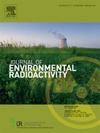Speciation and leachability of radiocesium in the soil, sediment, and aquatic organisms surrounding Lake Onuma at Mt. Akagi
IF 2.1
3区 环境科学与生态学
Q3 ENVIRONMENTAL SCIENCES
引用次数: 0
Abstract
The 2011 accident at the Fukushima Daiichi Nuclear Power Plant resulted in the widespread release of radioactive cesium (radiocesium, including 134Cs and 137Cs) across Fukushima Prefecture and its neighboring regions. This study investigates temporal changes in radiocesium, focusing mainly on 137Cs, concentrations and their speciation using a sequential extraction procedure in Lake Onuma, an isolated mountain lake, from 2011 to 2019. The 137Cs concentrations in various environmental samples decreased markedly until 2014 and then reduced gradually after 2015. This trend may be attributable to the relatively long water residence time (∼2 years) in the lake, with limited upstream inflow and downstream discharge. The sequential extraction procedure revealed that insoluble forms of 137Cs in lake sediment and the surrounding soils decreased more slowly than soluble forms, which predominated in phytoplankton (PP), zooplankton (ZP), and wakasagi smelt (Hypomesus nipponensis). Throughout the nine-year study period, 137Cs concentrations in plankton exhibited the following order: PP (1850–390 Bq kg−1) > ZP (395–69 Bq kg−1), contrasting expectations regarding bioaccumulation patterns within the food chain, suggesting that the insoluble 137Cs species in PP may originate from mineral-rich suspended solids near the lake sediment surface. These findings highlight the importance of continued monitoring and contribute to a deeper understanding of the long-term ecological impacts associated with the Fukushima Daiichi Nuclear Power Plant accident.

赤城山大沼湖周围土壤、沉积物和水生生物中放射性元素的形态和淋滤性
2011年福岛第一核电站事故导致放射性铯(放射性铯,包括134Cs和137Cs)在福岛县及其周边地区广泛释放。本研究对2011年至2019年孤立的高山湖泊大沼湖放射性铯的时间变化进行了研究,主要关注137Cs的浓度及其形态。各环境样品中137Cs浓度在2014年前呈明显下降趋势,2015年后逐渐下降。这一趋势可能是由于湖水停留时间较长(~ 2年),上游流入和下游流量有限。结果表明,137Cs在湖泊沉积物及其周围土壤中的不溶性形态比可溶性形态减少得更慢,主要分布在浮游植物(PP)、浮游动物(ZP)和若asaki熔体(Hypomesus nipponensis)中。在9年的研究期间,浮游生物中137Cs的浓度表现出以下顺序:PP (1850-390 Bq kg - 1) > ZP (395-69 Bq kg - 1),这与人们对食物链中生物积累模式的预期形成了对比,表明PP中不溶性137Cs可能来自湖泊沉积物表面附近富含矿物质的悬浮固体。这些发现强调了持续监测的重要性,并有助于更深入地了解与福岛第一核电站事故相关的长期生态影响。
本文章由计算机程序翻译,如有差异,请以英文原文为准。
求助全文
约1分钟内获得全文
求助全文
来源期刊

Journal of environmental radioactivity
环境科学-环境科学
CiteScore
4.70
自引率
13.00%
发文量
209
审稿时长
73 days
期刊介绍:
The Journal of Environmental Radioactivity provides a coherent international forum for publication of original research or review papers on any aspect of the occurrence of radioactivity in natural systems.
Relevant subject areas range from applications of environmental radionuclides as mechanistic or timescale tracers of natural processes to assessments of the radioecological or radiological effects of ambient radioactivity. Papers deal with naturally occurring nuclides or with those created and released by man through nuclear weapons manufacture and testing, energy production, fuel-cycle technology, etc. Reports on radioactivity in the oceans, sediments, rivers, lakes, groundwaters, soils, atmosphere and all divisions of the biosphere are welcomed, but these should not simply be of a monitoring nature unless the data are particularly innovative.
 求助内容:
求助内容: 应助结果提醒方式:
应助结果提醒方式:


